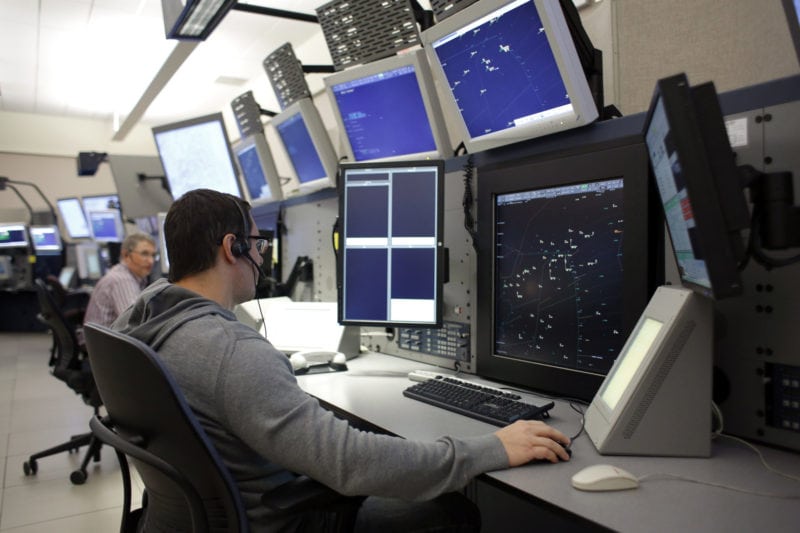
NAV Canada air traffic controllers, such as those pictured here, will use space-based ADS-B when the global Iridium NEXT constellation becomes operational in 2018. Photo: Nav Canada.
Now that the first 10 satellites of the Iridium NEXT constellation have launched, Aireon can begin the initial process of testing and validating its space-based automatic dependent surveillance-broadcast (ADS-B) global air traffic surveillance network.
SpaceX launched the first 10 Iridium NEXT satellites into low-earth orbit on Jan. 14. The launched marked the first in a series of seven under a partnership between Iridium and SpaceX to take place over the next 17 months. All 66 of those satellites are equipped with Aireon’s Harris Corp.-designed space-based ADS-B payload, capable of capturing ADS-B messages from aircraft equipped with 1090 MHz extended squitter (1090ES) transponders.
According to a recent blog post by Aireon’s chief technology officer, Vincent Capezutto, Aireon has already been able to validate that the ADS-B payloads survived the launch. Aireon engineers in late January conducted initial operational tests that verified the performance of the space-to-earth communications link and dated 150 total ADS-B aircraft over thousands of ADS-B messages received and decoded.
“It was a very limited test, but also a very early indication that we were seeing aircraft in a bunch of different configurations,” Aireon CEO Don Thoma told Avionics. “We were able to see that the performance in the system was pretty good. Having said that, it’s only the beginning.”
Testing of the space-based ADS-B payloads will continue through mid-2018, which is the targeted date for when the full array of 66 satellites will be in operation. In addition to the testing Aireon has to perform on its payloads, Iridium, Orbital ATK and Thales Alenia Space have to test and the satellites themselves, which are a completely new design and have the ability to communicate with each other to create a mesh network in the sky.
Iridium transfers testing of the ADS-B payloads for verification of on-orbit technical specifications about 40 to 60 days after each series of satellites is launched. The space-based ADS-B receivers are designed to provide air traffic surveillance data from 1090ES-equipped aircraft to service delivery points at NAV CANADA, NATS, ENAV, the Irish Aviation Authority (IAA), as well as the FAA’s William J. Hughes Technical Center in Atlantic City, New Jersey.
Over the last two years, Aireon has also progressively signed data service agreements with other air navigation service providers (ANSPs), such as the most recent one with Iceland’s Isavia. The space-based ADS-B network has promised to revolutionize global air traffic surveillance, eliminating the possibility of aircraft going missing from ground-based radar surveillance, the most famous example being the Malaysian Airlines MH370 incident. According to Aireon, more than 70% of the earth, including oceanic and remote airspace currently has no existing air traffic surveillance.
The new network could also help to enhance aircraft separation required in some of the world’s busiest oceanic airspace, such as the North Atlantic Track System, where thousands of aircraft fly everyday between North America and Europe. Thoma said Aireon wants to test a range of different traffic scenarios.
“We’ll be doing a whole series of different tests that verify performance in many of the different operating scenarios, including a high-traffic area like the east coast of the U.S.,” he said. “We’ll look at oceanic operations, low power transponders, all those things that will verify the performance.”
The Iridium NEXT constellation will see its low earth orbiting satellites passing over every major portion of airspace in the world, allowing Aireon to verify performance everywhere it needs to. Flight-testing will also be performed for more detailed verification with highly instrumented aircraft operated by the FAA’s technical center and NAV Canada aircraft. Thoma said flight testing will also occur in dense airspace such as the New York oceanic region, one of the busiest airspaces in the world. This is so that space-based ADS-B performance can be verified where multiple aircraft within a single airspace are squawking 1090 messages at the same time.
The testing will also help confirm performance for applications of space-based ADS-B for which other companies want to use the network. For example, Aireon has a partnership with FlightAware and SITAOnAir to enhance the realtime flight tracking capabilities of the SITAOnAir flight tracker system. Its flight tracker uses multiple aircraft onboard sources and equipment to provide position report updates for operators. However, the company sees its partnership with FlightAware and Aireon bringing in space-based ADS-B data that can provide increased coverage for aircraft with no satcom equipment flying in polar, remote and poorly connected regions.
“Any aircraft equipped with a 1090 ADS-B transponder we should see. It’s just a question of how often do we see it,” said Thoma. “We’re anxious to get into the detailed testing, even though we’re encouraged by this very early what we’ve seen. That doesn’t mean the job is done and everything is working perfectly. From our view, it’s very encouraging.”